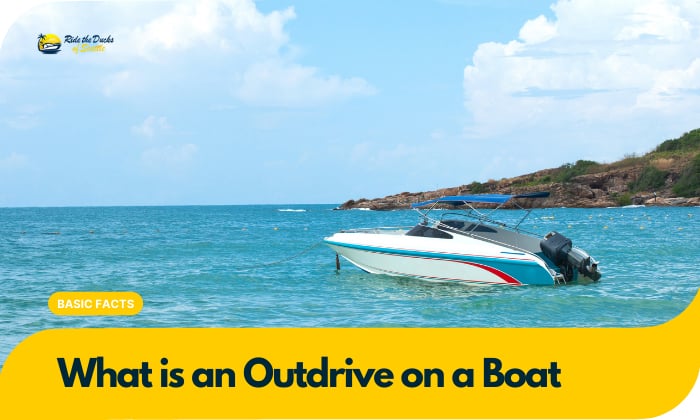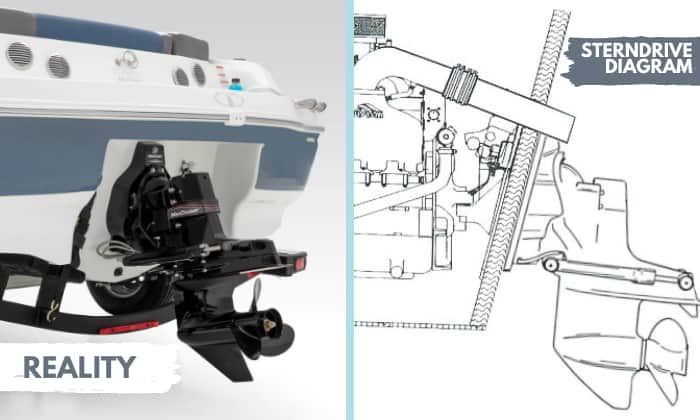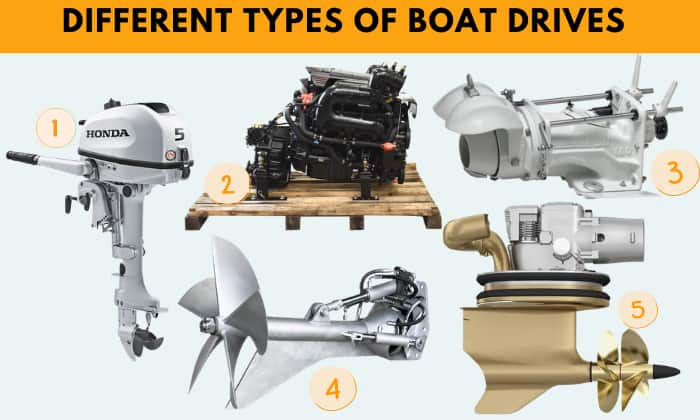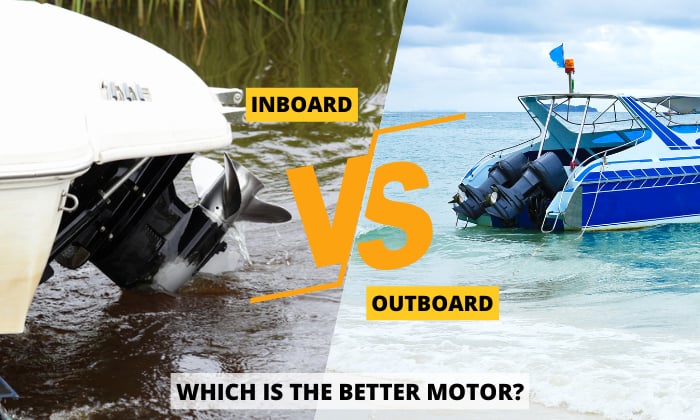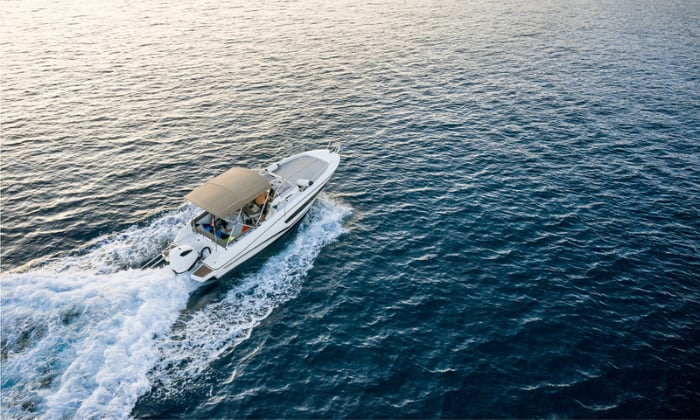What is an outdrive on a boat? An outdrive is a propulsion system consisting of an inboard engine and an outboard unit. Outdrives are commonly seen on smaller boats, but sometimes they’re also equipped on larger vessels like cruisers and yachts.
Is your boat sporting an outdrive propulsion system? Do you know how it works? What’s the thing that separates it from the other? How do you compare stern drive boat vs outboard or inboard vs outboard vs sterndrive?
Let’s find out!
Table of Contents
Function and Definition
Let’s talk about the definition first. An outdrive is a propulsion system used on boats. It converts engine power into movement via a combination of an inboard engine and an outboard drive unit that is mounted to the transom of the boat.
The outdrive includes a drive shaft, a propeller, and a gearbox. This drive unit transfers power to the propeller on the outboard unit, propelling the boat through the water.
The outdrive is either hooked with the inboard engine or an outboard motor mounted on the rear end of the boat. Since the outdrive is placed at the stern of a boat, it is also called a sterndrive.
What does stern mean, though? The stern is the outside rearmost part of the boat, as opposed to the bow. A sterndrive engine, or an inboard/outboard (I/O) engine, combines an inboard engine with an outboard drive unit, making it the best of both worlds.
Regarding stern drive vs inboard, there is not much of a difference between the two since they both employ inboard engines.
The sterndrive diagram below demonstrates how the system is constructed.
A captain steers his boat by pivoting the outdrive without needing any rudder. The inboard engine generates power through an electric combustion system that is transferred to the outdrive, thus rotating the propeller to move the boat.
Thanks to this optimal design of I/O engines, outdrives are able to reduce drag and consume less gasoline than a regular inboard shaft drive boat.
Types of Boat Drives
Besides outdrives, here are other boat drive types you may encounter:
- Outboard Engines: Outboard engines are self-contained units that are mounted outside the boat on the transom. Everything, including the engine, gearbox, and propeller, is fitted in a compact unit.
- Inboard Engines: Inboard engines are mounted inside the hull of the boat. They are connected to the propeller via a driveshaft.
- Jet Drives: Jet drives use a jet of water to propel the boat forward instead of a traditional propeller. They are commonly used in smaller boats to capitalize on their great maneuverability.
- Surface Drives: Surface drives use a propeller that is partially or fully above the surface of the water. They offer excellent speed and maneuverability. High-performance boats often use surface drives.
- Pod Drives: Pod drives are a propulsion system that uses a steerable pod that contains the engine, gearbox, and propeller. They are typically more efficient and maneuverable than traditional inboard engines.
Is It Better to Have an Inboard or Outboard Motor?
The answer relies on your type of boat and your budget.
Regarding the cost, inboard engines tend to run longer than their outboard ones, approximately 1,500 hours before needing maintenance. Also, inboard boat transmission work mechanism is similar to that of an automobile, so it gives a car-like feel when steering your boat with this type of engine.
On the other hand, outboard motors can only do 750 hours, nearly half of their counterparts.
Even though inboard engines usually cost more, they require less maintenance. Dealers also offer better insurance for inboard motors. However, outboards also have their advantages. Outboard motors are significantly more powerful and they can give off more horsepower. They’re also affordable to buy and maintain.
See the table below for more insight.
|
Inboard |
Outboard |
|
|
Types of Boats Suitable |
Bow riders, ski boats, or mid and large size cruisers | Pontoon, bass boats, fishing boats, small cruisers |
Inboard
- Leaves you with more storage space
- Lightweight
- User-friendly
- Easy maintenance
- Noisy
- Unaesthetic setup
- Few models available on models manufactured between 1990 – 2000
Outboard
- Fuel-efficient
- More powerful
- Affordable
- Quieter operation
- Car-like feel
- Longer life span
- More prone to damages
- Takes up more space
- Expensive maintenance
- Quite heavy
Related: Top-rated Fuel Additive for 4-Stroke Outboard
Frequently Asked Questions
Which are the Most Common Problems of the Outdrive on a Boat?
The most commonly seen stern drive problems are physical damages. Since the propeller is exposed at the back of the boat, it is more likely to encounter floating debris in the water like coral outcrops or even submerged rocks.
Consequently, outdrives may require frequent repairs and maintenance compared to other systems. Ask your local marine mechanics to know more about the outdrive boat repair cost as well as outdrives for sale; it varies depending on how bad the damage is.
What are the Qualities of a Sterndrive Boat Engine?
Here are some of the key qualities of a stern drive boat engine:
- Aerodynamic construction: Though there are different designs for a boat outdrive nowadays, aerodynamic construction is commonly seen among them.
It is visible that the front appears to be bigger, then gradually thins out as it gets to the back. This design aids in minimal resistance and effective propulsion.
- Cooling systems: An inboard outdrive often comes with an exhaust pipe to make sure the motor stays cool when operating. Other designs even have water-repelling flaps for the same purpose.
Tiny holes are also seen within the motor for proficient engine cooling.
- Fail-safe mechanism: These systems ensure the boat gets minimal damage if it ever hits bottom by using enough force to push the boat up top. If you’re lucky, odds are the stern drive motor will stay damage-free too!
- Saltwater Use: When frequently exposed to saltwater, zinc anodes will be attached to link outdrives to your vessel. These anodes will eventually corrode away as a replacement for the metal parts of the sterndrive.
Conclusion
What is an outdrive on a boat? Think of it as a perfect mix between an inboard and outboard motor setup that brings out the optimal features to make steering easy and effortless.
Sterndrives are worth investing in regardless of their drawbacks. At the end of the day, it all comes down to what your boat type is and your purpose of use to choose the most suitable drive for your vessel.
Read more: V Drive vs Direct Drive Systems

Ten years of enjoying countless trips on boats never made me love them any less! So I am here to put all those experiences into good use for other boaters who want to have a safe and fun trip with their friends and families.

